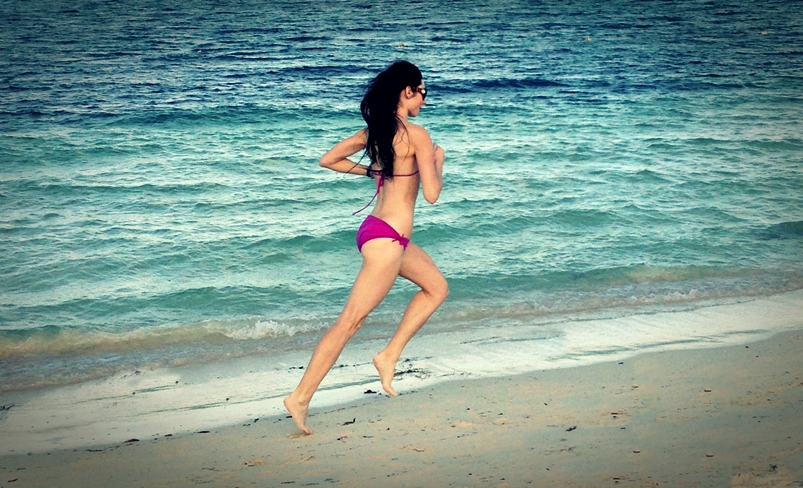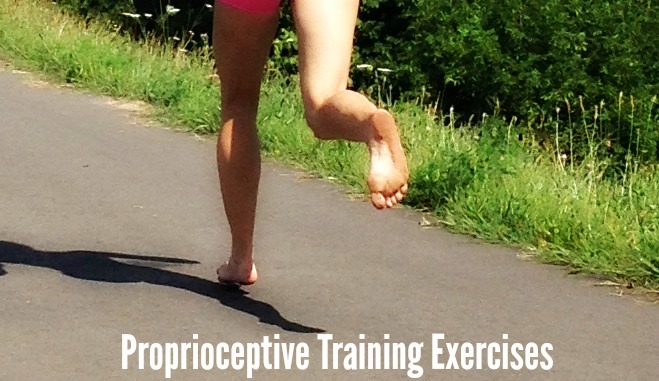The best proprioceptive training exercises for the feet is to walk barefoot and run barefoot as these exercises reverse the proprioceptive loss caused by cushioned running shoes. The result? Less injury to the leg and feet. Here’s why.
Best Proprioceptive Training Exercises for Runners
Running barefoot increases proprioception in the sole of the foot, which improves forefoot strike. Feeling the surface characteristics of the ground during barefoot running also promotes better leg stiffness modulating behavior, helping reduce impact.
Unfortunately, running shoes prevent us from ‘feeling’ the environment by interfering with the communication of relaying tactile information between the foot and the brain. Countless studies have also found that stiff, cushioned running shoes with corrective features weakens the feet at a fast rate, and causes knee pain.
- the modern running shoe restricts the reflexes and muscle activity of the foot, leading to discomfort and soft tissue degeneration.
The truth is, inflexible, cushioned-heeled running shoes are a mousetrap for chronic running injuries in addition to poor foot-health.
Landing Better Barefoot
Running barefoot tremendously improves foot health by maximizing proprioceptive feedback of the plantar surface.
 It turns out, proprioceptive feedback strengthens the ankle plantarflexors by unimpairing foot-placement and promotes better awareness in the central nervous system. This helps the body distinguish impact intensity, all of which lower the risk of an ankle injury.
It turns out, proprioceptive feedback strengthens the ankle plantarflexors by unimpairing foot-placement and promotes better awareness in the central nervous system. This helps the body distinguish impact intensity, all of which lower the risk of an ankle injury.
- proprioception activates reflexes, helping the central nervous system make decisions on foot placement and stability to avoid high impact landing
- running barefoot helps avoid painful impacts by encouraging leg stiffness modulation, particularly by increasing knee compliance, to reduce repetitive impact shocks
- even walking barefoot, especially on uneven surfaces, have been found to significantly improve longitudinal arch strength, improve symptoms of plantar fasciitis, and slows the progression of knee osteoarthritis
Another payoff of running barefoot is that since it allows for a stronger, more flexible foot, a strong foot is better able to control excessive pronation and other movement impairments of the foot implicated in running-related injuries.
More on Why Cushioned Running Shoes Harm Runners:
PS. Don’t forget to check out the Run Forefoot Facebook Page, it’s a great place to ask questions about forefoot running, barefoot running, and footwear. I’ll be happy to answer them for ya!
References:
Guskiewicz, KM and Perrin, DH. (1996). Effect of orthotics on postural sway following inversion ankle sprain. J Orthop Sports Phys Ther, 23(5):326-31.
Li, JX., Xu, DQ and Hoshizaki, B. (2009). Proprioception of foot and ankle complex in young regular practitioners of ice hockey, ballet, and running. Res Sport Med, 17(4):206-16.
Bretta Riches
BSc Neurobiology; MSc Biomechanics candidate, ultra minimalist runner & founder of RunForefoot. I was a heel striker, always injured. I was inspired by the great Tirunesh Dibaba to try forefoot running. Now, I'm injury free. This is why I launched Run Forefoot, to advocate the health & performance benefits of forefoot running and to raise awareness on the dangers of heel striking, because the world needs to know.
Latest posts by Bretta Riches (see all)
- Heel Strike Running Causes Slipped Discs - 25/04/2024
- How to Train Yourself to Not Heel Strike When Running - 24/04/2024
- Cushioned Running Shoes Found to Be Bad for Ankles - 23/04/2024


Leave a Reply